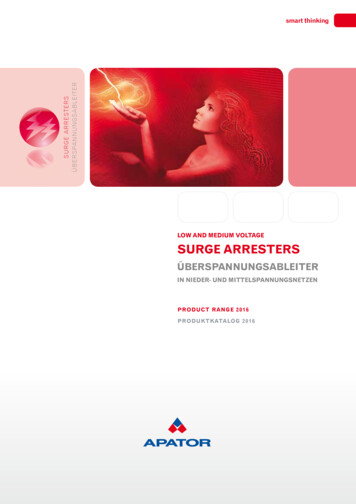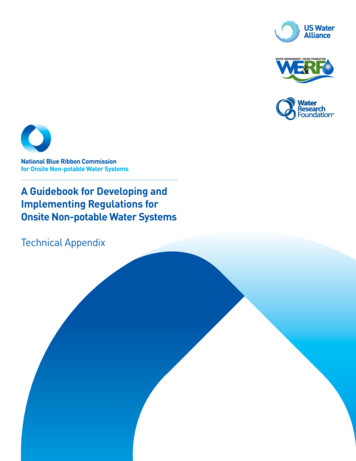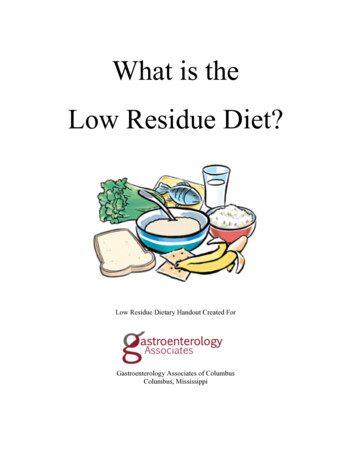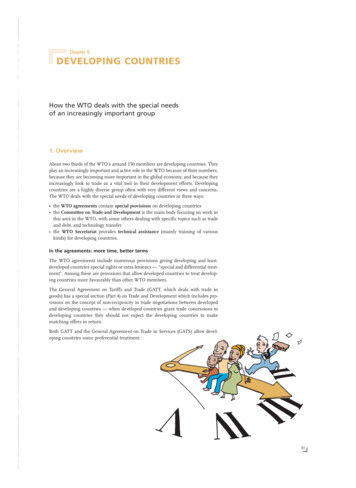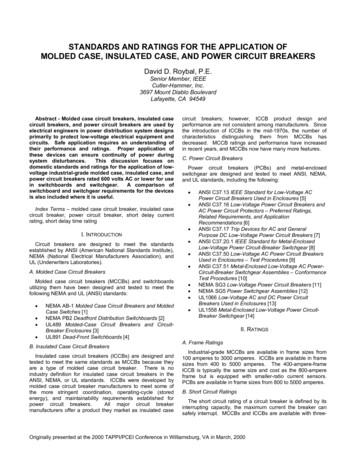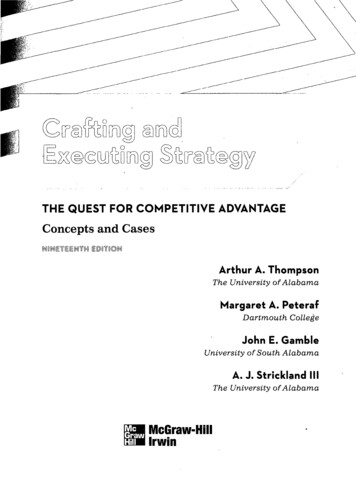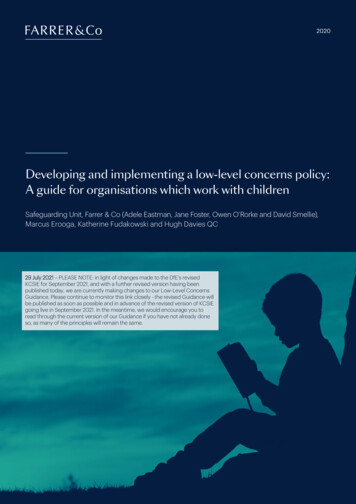
Transcription
2020Developing and implementing a low-level concerns policy:A guide for organisations which work with childrenSafeguarding Unit, Farrer & Co (Adele Eastman, Jane Foster, Owen O’Rorke and David Smellie),Marcus Erooga, Katherine Fudakowski and Hugh Davies QC29 July 2021 – PLEASE NOTE: in light of changes made to the DfE’s revisedKCSIE for September 2021, and with a further revised version having beenpublished today, we are currently making changes to our Low-Level ConcernsGuidance. Please continue to monitor this link closely - the revised Guidance willbe published as soon as possible and in advance of the revised version of KCSIEgoing live in September 2021. In the meantime, we would encourage you toread through the current version of our Guidance if you have not already doneso, as many of the principles will remain the same.
Developing and implementing a low-level concerns policy:A guide for organisations which work with children1.Introduction1.1 Organisational culture is a ‘slippery’ concept –often referred to but rarely defined. It is culture,however, that sets the context and expectationsof all behaviour in an organisation, and a positiveculture where concerns can be identified andspoken about openly is a key element of a strongsafeguarding system.1.2 What that means in practice is that ensuring that allthose who work with children behave appropriately,and the early identification and prompt andappropriate management of concerns aboutadults, is critical to effective safeguarding.1.3 Creating a culture in which all concerns about adults(including where the threshold for an allegation isnot met) are shared responsibly and with the rightperson, and recorded and dealt with appropriately, iscrucial. If implemented well this should encourage anopen and transparent culture; enable organisationsto identify concerning, problematic or inappropriatebehaviour early; minimise the risk of abuse;and ensure that adults working for or with theorganisation are clear about professional boundariesand act within them, in accordance with the ethosand values of the organisation.1.4 Behaviour which is not consistent with thestandards and values of an organisation, and whichdoes not meet the organisational expectationsencapsulated in their Code of Conduct, needsto be addressed.1 Such behaviour can existon a wide spectrum – from the inadvertent orthoughtless, through to that which is ultimatelyintended to enable abuse. Where a concern aboutan individual’s behaviour reaches the threshold ofan allegation, clear guidance exists (as referred tobelow) on how organisations should report, recordand manage it.2 Where a concern falls below thatthreshold the position is much less clear.1.5 Following Farrer & Co’s role as Secretariat to HughDavies QC on his independent review in 2014arising from the criminal conduct of William Vaheyat an international school (the Davies Review),3 andone of his principal recommendations regarding‘neutral notifications,’ Farrer & Co has assisted anumber of schools with introducing a formal writtenpolicy on sharing low-level concerns (as we nowcall them), or neutral notifications (as some othersrefer to them), regarding an adult’s behaviourtowards children. We have also been aware thatwhilst some schools (and other organisations)may not have introduced a formal policy, they maynonetheless encourage an approach to sharing lowlevel concerns/neutral notifications.1.6 We, together with Hugh Davies QC, Marcus Eroogaand Katherine Fudakowski, believe – based onempirical evidence and our respective experience– that there is considerable potential in this contextto create a safer environment for children, and thatthere is a need for a revised national approach – inorganisations which work with children across allsectors – including, for example, schools, charities,and sports organisations. If this is not adopted,such organisations risk enabling the creation offurther victims through missed opportunities toidentify and effectively intervene in concerning,problematic or inappropriate behaviour.1.7 This guidance draws on the following to explain howorganisations which work with children can developand implement a written low-level concerns policy,as part of a culture that enables staff to share anyconcerns – no matter how small, and how theseorganisations should respond to them: our experience, inquiries, serious case reviews,and published research – including, for example,that of Marcus Erooga, who considered commonfactors in organisational child sexual abuse in areview of 20 serious case reviews relating to suchabuse in the UK from 2010-2016 (as referred to inmore detail on page 4); and recent research undertaken by the SafeguardingUnit at Farrer & Co, in conjunction with MarcusErooga, which involved us designing two versionsof a questionnaire – one for schools at whichan approach is being taken to sharing low-levelconcerns/neutral notifications (approach), andanother for schools at which a formal policy existson sharing low-level concerns/neutral notifications(policy). A total of 18 schools responded – 13 ofwhich completed the approach questionnaire,and 5 completed the policy questionnaire (ourresearch). Whilst we consider the data obtainedto be valuable, we are mindful that there arelimitations in terms of the methodology used –including the fact that it is a small sample, and thatthere are a number of potential ‘biases.’ Furtherinformation on the research and data collated canbe found in Appendix G.1.8 We recognise that there is some resistance withinthe safeguarding field to the concept of anythingbeing a ‘low-level’ concern; however, we use it1 As referred to later in this guidance, the Code of Conduct will ideally be informed by the following: Safer Recruitment Consortium (2019) Guidance for safer working practice for thoseworking with children and young people in education settings (GSWP), accessed on 8 October, 2019 at Sept%202019.pdfGovernment (2018) Working Together to Safeguard Children: A guide to inter-agency working to safeguard and promote the welfare of children (WTSC), accessed on 8October, 2019 at -together-to-safeguard-children--2; Department for Education (2019) Keeping Children Safe in Education:Statutory guidance for schools and colleges (KCSIE), accessed on 8 October, 2019 at -children-safe-in-education--2; and,for example, London Child Protection Procedures (LCPP), Part A, Chapter 7, accessed on 8 October, 2019 at https://www.londoncp.co.uk/chapters/alleg staff.html3 Davies, H. (2014) Southbank International School Independent Review arising from the criminal conduct of William Vahey: Interim Report, London, Farrer and Co, LLP; and Davies,H. (2014) Southbank International School Independent Review arising from the criminal conduct of William Vahey: Final Report, London, Farrer and Co, LLP2 HM1
Developing and implementing a low-level concerns policy:A guide for organisations which work with childrenas a clear and comprehensible term to neutralisethe act of sharing a concern which neither meetsthe allegation threshold set out below, nor isotherwise serious enough to consider a referral tothe LADO. We believe that such straightforward andcomprehensive shorthand is both necessary andeffective in practice.1.9 Whilst we consider a written ‘low-level concerns’policy to be an important part of the suite ofsafeguarding policies that exists at an organisationwhich works with children, its successful introductionwill be a process rather than an event. Having theconfidence of all staff that it will, in practice, be usedin the way the policy describes will be a key part ofensuring it is implemented and used successfully. Astarting point for any organisation is realistically toassess its own organisational culture, and considerwhether it is currently conducive to introducing sucha policy and, if not, what action it needs to take toreach that position.1.10 This guidance focuses on low-level concernsregarding adults’ behaviour towards children –including the options of self-reporting by adults, oradults sharing such concerns about the behaviourof other adults. Whilst it does not focus on thesharing of concerns (i) about adults by children,or (ii) in the context of peer-on-peer abuse, or (iii)in the context of adults’ behaviour towards adults,we believe that the same fundamental principlesshould nonetheless apply.2.Definitions2.1Reference in this guidance to:2.1.1 ‘staff’ should be interpreted very widely tomean anyone associated with the organisation– i.e. whether working for or with theorganisation, engaged as a paid employee,worker or self-employed contractor, or unpaidmember of staff or volunteer. It also includesanyone who is part of the Governance Body;2.1.2 ‘Governance Body’ means those individualswho are responsible for an organisation’sgovernance – for example, in a school setting,the governors; in a charity, the trustees; and ina sports organisation, the directors;2.1.3 ‘Safeguarding Lead’ means the person inan organisation with overall safeguardingresponsibility. In a school setting, this personis normally referred to as the DesignatedSafeguarding Lead (DSL). The SafeguardingLead is distinct from the designated officeremployed by the local authority to manageand have oversight of allegations across thechildren’s workforce (LADO); and452.1.4 ‘values guardian’ or ‘safeguarding champion’are terms that some organisations use todescribe members of staff who are specificallyselected and trained to be available and tolisten to any low-level concerns that staff maybring to their attention, and to share them withthe Safeguarding Lead.3. Thedistinction between an allegation and alow-level concern3.1Allegation3.1.1 The term ‘allegation’ means that it is allegedthat a person who works with children has: behaved in a way that has harmed achild, or may have harmed a child; possibly committed a criminal offenceagainst or related to a child; or behaved towards a child or children in a waythat indicates they may pose a risk of harmto children.43.1.2 Chapter 7 of Part A of the London ChildProtection Procedures (LCPP) makes itclear that an allegation can also relate to anadult’s behaviour outside of work, and theirrelationships with others, if they: have behaved in a way in their personal lifethat raises safeguarding concerns. Theseconcerns do not have to directly relate toa child but could, for example, include anarrest for the possession of a weapon; have, as a parent or carer, become subjectto child protection procedures; are closely associated with someone intheir personal lives (e.g. partner, memberof the family or other household member)who may present a risk of harm to child/renfor whom the adult is responsible in theiremployment/volunteering.53.1.3 Where the threshold of an allegation ismet, there is specific guidance on howorganisations should respond:(a) orking Together to Safeguard ChildrenW(July 2018) (WTSC) states that “ Anyallegation against people who work withchildren should be reported immediatelyto a senior manager within theorganisation or agency. The [LADO] orteam of officers, should also be informedwithin one working day of all allegationsThis definition is used in: WTSC, Chapter 2, paragraph 4; KCSIE, paragraph 195; LCPP, Part A, Chapter 7, paragraph 7.2.1; GSWP, paragraph 1LCPP, Part A, Chapter 7, paragraph 7.2.32
Developing and implementing a low-level concerns policy:A guide for organisations which work with childrenthat come to an employer’s attention orthat are made directly to the police.”6(b)(c) his obligation to report allegationsTapplies to schools and colleges, faithorganisations, and voluntary and privatesector organisations (amongst others).7However, in practice, all organisationsworking with children should takethis action. eeping Children Safe in EducationK(September 2019) (KCSIE) states that “Ifstaff have safeguarding concerns, or anallegation is made about another memberof staff (including volunteers) posing arisk of harm to children, then: this should be referred to theheadteacher or principal; where there are concerns/allegationsabout the headteacher or principal,this should be referred to the chair ofgovernors, chair of the managementcommittee, or proprietor of anindependent school; and in the event of concerns/allegationsabout the headteacher, where theheadteacher is also the sole proprietorof an independent school, allegationsshould be reported directly to thedesignated officer(s) at the localauthority .”8(d) More detailed guidance is set out in Part4 of KCSIE on handling allegations oncethey have been reported internally.(e) Although the guidance in KCSIE isspecifically applicable to schools andcolleges, it could, as a matter of bestpractice, be applied to any organisationworking with children.3.2. Low-level concern3.2.1 A low-level concern is any concern about anadult’s behaviour towards a child that does notmeet the allegation threshold set out above, oris not otherwise serious enough to consider areferral to the LADO.3.2.2 A low-level concern is any concern – no matterhow small, and even if no more than a ‘naggingdoubt’ – that an adult may have acted in amanner which: is not consistent with an organisation’s Codeof Conduct,9 and/or relates to their conduct outsideof work which, even if not linked to aparticular act or omission, has caused asense of unease about that adult’s suitabilityto work with children.103.2.3 S taff do not need to be able to determine ineach case whether their concern is a low-levelconcern, or if it is in fact serious enough toconsider a referral to the LADO, or meets thethreshold of an allegation. Once staff sharewhat they believe to be a low-level concern,that determination should be made by theSafeguarding Lead.3.2.4 Neither WTSC nor KCSIE provides any formalmechanism for handling concerns aboutadults working with children that do not meetthe threshold of an allegation.3.2.5 However, it is possible to introduce amechanism whereby low-level concerns areshared with the Safeguarding Lead, or withthe Safeguarding Lead or a values guardian/safeguarding champion – as appropriateto each organisation. In light of paragraph50 of KCSIE, as explained further below inparagraph 8.12, in a school or college, theSafeguarding Lead should then share anylow-level concerns immediately with theheadteacher or principal.3.2.6 The importance of such a mechanism isillustrated by research and reference toinquiries and serious case reviews.WTSC, Chapter 2, paragraph 7statutory duties are placed by Section 11 of the Children Act 2004 on a range of organisations and professionals working with children and families to safeguard andpromote the welfare of children. In addition, further safeguarding duties are placed on individual organisations through other statutes, as explained in Chapter 2 of WTSC8 KCSIE, paragraph 509 In some organisations this document is called the Behaviour Policy but reference is made to Code of Conduct throughout this guidance.10 Concerns which fall short of the allegation threshold might include an accusation that is made second or third hand and the facts are not clear, or the member of staff alleged tohave done this was not there at the time; or there is confusion about the account, LCPP, Part A, Chapter 7, paragraph 7.2.10.67 Specific3
Developing and implementing a low-level concerns policy:A guide for organisations which work with children4.The importance of sharing low-level concerns4.4 Erooga and colleagues’ research with offendersillustrates what organisational offenders can “Agencies providing services to children [ ] shouldteach organisations about how to prevent abuseensure that a culture of openness and trust isand build strong safeguarding cultures.19 Thosefostered within the organisation in which staff caninterviewed for the research had worked in ashare any concerns about the conduct of colleaguesrange of occupational settings (including schools,and be assured that these will be received in asports clubs, army and sea cadet organisations, asensitive manner.”11choir group and education social work), and hadsexually offended against children in organisational4.1 Organisational child sexual abuse is an increasinglypositions of trust. Whilst not necessarily causalwell-documented and understood phenomenon.12 Itfactors, a number reported work related stressorsis rare to find cases where the abuse occurred in the(including lack of support and working long hours),absence of preceding grooming by the offender,13as well as personal issues (including having beenand whilst not always,14 it is usually the case that suchabused themselves as children, recent loss ofpreparatory conduct was observed and regarded asintimate relationships, questioning their sexualquestionable at the time by others.15 It is not of courseorientation and a history of self-harm/suicidaljust children who are groomed but also, as multiplethoughts). Some showed patterns of rule breakingcases demonstrate, the potentially protective adultsmore generally (including breaches of other rules),and systems around them.16in addition to the abuse of children.4.2 Often a striking feature is that such conduct was notGrooming behaviours included direct use ofshared with the relevant individual at the organisation 4.5 authority to offend, using material or practicaluntil after substantive abuse was alleged against thebenefits for victims, providing support for isolatedoffender. In other respects, potentially questionablechildren, favouring particular children, and use ofconduct, even where shared, is consistently shownalcohol, videos or sexual imagery amongst others.not to have either been recorded or available forThe method of commencing the abuse included theevaluation as part of a history or pattern of behaviour,erosion of boundaries, slow progression to abuse,or not to have been escalated when a pattern of such17use of trust and authority, meeting the child’sbehaviour emerged.needs (including physical and emotional), and4.3 Common factors in organisational child sexualdeveloping relationships with the child’s family. Ourabuse were considered by Marcus Erooga in acollective observation is that these concepts arereview of 20 serious case reviews relating to suchstraightforward but staff do not understand themabuse in the UK from 2010-2016.18 He found that:unless there is training based on real life cases(discussed further at 6.5(f)).(a) a factor in 17 cases was a failure of staff andmanagement to understand and implement4.6 The research questions the view that all offenderstheir safeguarding policies (including aroundare preferential, suggesting instead that whilstsharing concerns);some are undoubtedly preferential, others maybe considered to be opportunistic and some are(b) emphasised in 14 reviews was the importancesituational. Preferential offenders are those whoof staff and management understanding thehave a conscious desire to sexually abuse children,dynamics of organisational abuse (includingand who either do not see, or are not easilygrooming); anddeterred, by obstacles. Jimmy Savile is a classic(c) a factor identified in 11 cases was theexample of a preferential offender. Opportunisticsignificance of organisational culture tooffenders are those who abuse because potentialminimise risk.victims are available and potentially vulnerable,11 SocialServices Inspectorate (1994) ‘An Abuse of Trust’, The Report of the Social Services Inspectorate Investigation into the case of Martin Huston, January 1994, Belfast, SocialServices Inspectorate12 Kaufman, K., Erooga, M. et. al. (2016) Risk profiles for institutional child sexual abuse: A literature review, Royal Commission into Institutional Responses to Child Sexual Abuse, Sydney13 McAlinden, A-M. (2012) ‘Grooming’ and the Sexual Abuse of Children: Institutional, Internet, and Familial Dimensions, Oxford University Press14 E.g. Scott-Moncrieff, L. and Morris, B. (2015) Independent investigation into governance arrangements in the paediatric haematology and oncology service at Cambridge UniversityHospitals NHS Foundation Trust following the Myles Bradbury case, Cambridge, Cambridge University NHS Foundation Trust (UK)15 See Appendix A for examples16 E.g. McAlinden, A. M. (2012) ‘Grooming’ and the Sexual Abuse of Children: Institutional, Internet and Familial Dimensions, Oxford, Oxford University Press; Exploring Sex offenderGrooming (2013) by Jim Tanner, Ph.D. KBSolutions Inc. and Stephen Brake, Ph.D.Stephen Brake Associates, accessed on 8th October, 2019 at http://www.kbsolutions.com/Grooming.pdf; Wonnacott, J. and Carmi, E. (2016) Serious Case Review: Southbank International School, Hammersmith and Fulham, Kensington & Chelsea and WestminsterLSCB; Raynes, B. (2011) Executive Summary Of Serious Case Review Written About Teacher Mr X, Hillingdon Local Safeguarding Board; Jones, P. (2016) Investigation IntoSafeguarding Issues At Clifton College Arising From The Prosecution Of X, Bristol: Clifton College; and East Sussex Safeguarding Children Board (2013) Serious Case Review: ChildG, Brighton, East Sussex Safeguarding Children Board17 See Appendix A for examples18 Erooga, M. (2016) Creating Safer Organisations: Practical implications of research regarding child sexual abuse in youth serving settings, Pre-conference presentation at theAssociation for the Treatment of Sexual Abusers (ATSA) 35th Annual Research and Treatment Conference, Orlando, FL., USA19 Erooga, M., Allnock, D. & Telford, P. (2012) Sexual Abuse of Children by People in Organisations: What Offenders can Teach Us About Protection in M. Erooga (ed.) Creating SaferOrganisations: Practical Steps to Prevent the Abuse of Children by Those Working With Them, John Wiley & Sons, Ltd4
Developing and implementing a low-level concerns policy:A guide for organisations which work with childrenand the organisational setting either inadvertentlyfacilitates, or fails to prevent, abusive activity.Situational offenders are those whose propensity toabuse is previously unknown or unacknowledged, andtheir offending is specific to the set of organisationalfactors which potentiates their offending.20Boundaries4.7 Based on the earlier research, Erooga elaborateson the concept of a ‘slippery slope’ of boundaryviolations towards abuse, and explains that thereare many stages on the slippery slope towardsthe breach of a boundary within a relationship.Sometimes initial infringements are part of agrooming process but at other times they are madeinnocently and with good intention. However,once boundaries are breached it then becomesmore difficult to restore the relationship to onein which proper boundaries are respected.21Furthermore, Erooga emphasises that organisationsshould not simply concern themselves withsafeguarding boundaries. His research indicatesthat organisations in which boundaries are adheredto in every respect in which staff perform their roleare likely to be the safest environments for children.Specific Behaviours4.8 Tabachnick and Baker’s research describes a widelyheld but erroneous perception that individuals canaccurately judge people, or profile a sex offender,and emphasises the need to understand that thereis no one profile to describe everyone who abusesa child and the importance, therefore, of a focusinstead on specific behaviours.224.9 If we educate adults to be informed about, and toidentify, concerning, problematic or inappropriatebehaviour, rather than think they can recognisedangerous people, they can be prepared to actwhen they observe behaviour which violates aCode of Conduct. They can, as Tabachnick andBaker explain, then draw attention to “the hundredsof small comments, harassments, emotional andphysical boundary violations, and other signs thatmay precede [child] sexual abuse” – what may beconsidered in the broadest sense to be [part of aconscious, or an unwitting] grooming process.234.10 In this approach a clear and robust Code ofConduct for the workplace is needed, and theremust be a commitment from leadership toadhere to, enforce and reinforce the Code and itsexpectations, and to address any attempt to bypasspolicies or procedures – regardless of the personin question’s status. Staff should be briefed on theCode of Conduct so that everyone is familiar with it,and clear on the standard of behaviour expected ofthem – it should be a lived document, seen to applyto all levels of the organisation. Staff should also betrained on specific behaviour to be aware of, and beencouraged and empowered to share any concernsabout behaviour that is not appropriate. Intrinsic tothis is discussing, during training, real life examplesof the consequences of failing to report.Action points “It is not whistleblowing, which is the safety net atthe end of the process, but mechanisms that allowthe confidence to speak out on a day-to-day basis.How do you create that culture? You need a robustframework, policy, training, support and leadershipto facilitate dialogue and instil it.”24 (Sam Monaghan, Corporate Director Children’sServices, Barnardo’s)4.11 W hether or not all child sex offenders are in factpreferential, there are several recommended actionsthat flow from Erooga and colleagues’ research,25and that organisations can take to minimise the riskof situational offending. They include:(a) reducing the opportunity and acceptabilityof concerning, problematic or inappropriatebehaviour;(b) increasing the effort required to offend;(c) increasing the risk and perception of the riskof detection;(d) ensuring there are robust and effective staffsupport systems in place;(e) not over-relying on DBS or overseas criminalrecords checks – they are essential (where rolesrequire them, and as a matter of compliance)but are not a silver bullet. A clear DBS checksimply confirms that an individual has not beendiscovered to present a risk to children; it isnot predictive about potential risk. Researchshows that the majority of organisational childsex offenders did not have a previous criminalrecord at the time they offended, although20 Erooga,M. (2018) Thinking Beyond a Single Type of Organisational Sex Offender’ in M. Erooga, M. (ed.) Protecting Children and Adults from Abuse After Savile, London, JessicaKingsley Publishers21 Ibid22 Tabachnick, J. and Baker, K. (2018) ‘Engaging the Public through Messaging and Bystander Actions’ in M. Erooga, M. (ed.) Protecting Children and Adults from Abuse After Savile,London, Jessica Kingsley Publishers23 Ibid, p.17324 Sam Monaghan, Corporate Director Children’s Services, Barnardo’s, quoted in Charity Finance (April 2016) Safe Keeping: the implications of historic child sexual abuse allegations25 Erooga, M., Allnock, D. & Telford, P. (2012) Sexual Abuse of Children by People in Organisations: What Offenders can Teach Us About Protection in M. Erooga (ed.) Creating SaferOrganisations: Practical Steps to Prevent the Abuse of Children by Those Working With Them, John Wiley & Sons, Ltd5
Developing and implementing a low-level concerns policy:A guide for organisations which work with childrenthey may subsequently be found to have hadnumerous previous victims; 26(f) t he powerful effect of organisational culture –and the importance of clarity and congruenceabout values and expectations. As the Health& Safety Executive states, culture can best bedescribed as “the way we do things aroundhere.” 27 What is important is creating a robust,holistic safeguarding culture that everyoneendorses and is committed to. As oneheadteacher commented, “It is about buildinga culture of what is and isn’t acceptable here.What are we about as a school? What is the staffroom like and is everyone buying into that?”Culture forms the context within which peoplejudge the appropriateness of their behaviour.An organisation’s culture will influence humanbehaviour and human performance at work,and it is vital to recognise the danger ofcultural slippage. A Code of Conduct which isunderstood, accepted and followed by all adultsassociated with the organisation is integral to this,and strong governance and leadership are vital.4.12 In addition, all organisations can benefit fromusing the Guidance for safer working practice forthose working with children and young people ineducation settings (GSWP), which is used by manylocal authorities and schools as a reference pointfor identifying low-level concerns and informingtheir own Code of Conduct.28 Although createdfor schools and education settings, the principlesare applicable across all sectors, and as guidanceit is held in high regard by professionals within thesafeguarding field.5.What can we learn from serious case reviews? “ I would like to stress that our review hashighlighted the overwhelming importance of twothings for organisations in protecting children – aculture of openness, including a willingness torecognise and accept that abuse could happen inany organisation and a robust structure to supportthe effective reporting and handling of concernsabout behaviour.”29(Dame Moira Gibb)5.1 The importance of educating staff to understand andidentify behaviour which is contrary to the Code ofConduct is illustrated by the table at Appendix A,which draws together the key features of fifteen casesof organisational child sexual abuse.305.2 In the cases of teachers William Vahey and NigelLeat (further details of which can be found inAppendix A), a number of staff, parents and pupilsdiscussed concerns with each other or a memberof the senior management team. A number ofthese concerns, taken in isolation, were not treatedby the teachers’ respective schools as meetingthe threshold for reporting to the LADO at thetime. For example, Vahey “undermined other staffand was disrespectful to junior staff,” and “gaveout chocolates and sweets in clas
A guide for organisations which work with children 2. 6 WTSC, Chapter 2, paragraph 7 7 Specific statutory duties are placed by Section 11 of the Children Act 2004 on a range of organisations and professionals working with children and families to safeguard and promote the welfare of children
